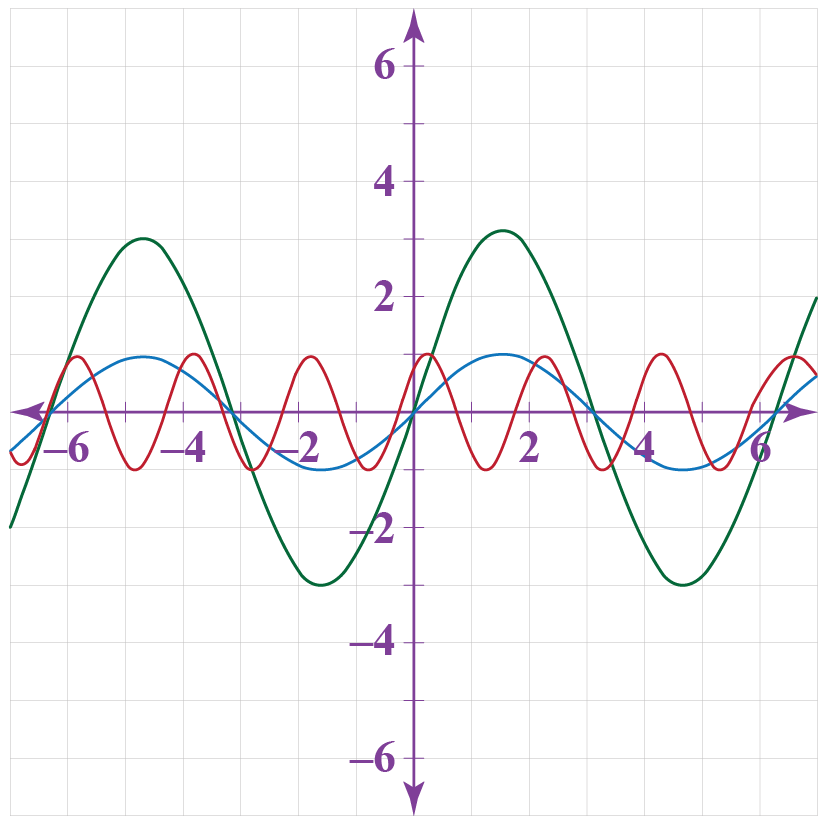There are four types of transformation possible for a graph of a function, which are:
- Rotations
- Translations
- Reflections, and
- Scaling
Further, scaling can be divided into two different types, i.e.,
- Horizontal scaling
- Vertical scaling

In this section, we will learn about vertical scaling in detail and practice solving questions around it.
You can check out the interactive simulations to know more about the lesson and try your hand at solving a few interesting interactive questions at the end of the page.
Lesson Plan
Scaling is a process of changing the shape and size of the graph of the function.
Vertical scaling refers to changing the shape and size of the graph of the function along the y-axis and is done by multiplying the function by some constant.
Suppose, we have a function, ( y = f(x))
Vertical scaling of the above function can be done just by multiplying the function with a constant C, i.e.,
[y = Cf(x)]Example
We have a function (y = f(x))

We have multiplied the function with 2, i.e., [y = 2f(x)]
We get,

The distance of the points on the curve gets farther away from the x-axis.
The shape of the curve depends on the value of C:
- If C > 1, the graph stretches and makes the graph steeper.
- If C < 1, the graph shrinks and makes the graph flatter.
The point on f(x) The point on y = Cf(x) ( (x, y) )
( (x, Cy ))
Steps
Step 1: Select the constant by which we want to scale the function.
Here we have selected ( color{orange}{+2}).
Step 2: Write the new function as ( g(x) = Cf(x) ), where C is the constant.
Here, our equation of the new function will be
[g(x) = color{orange}{2} f(x) = color{orange}{2} x^2 ]Step 3: Trace the new function graph by replacing each value of y by Cy.
Here we have to replace the value of y-coordinate by (color{orange}{2}y).
Y coordinate of each point in the graph is multiplied by (pm C), and the curve shrinks/stretches accordingly.
Here, we have the graph of (x^2) and it is stretched by a factor of (color{orange}{+2}) units in the y-direction.

Here, we have got (color{orange}{+2} ) units vertically scaled graph of (x^2) or of the function (g(x) = 2x^2 ).
Note: as we have scaled it with a factor of (color{orange}{+2} ) units, it has made the graph steeper.
Vertical scaling of various graphs of the functions are shown below:
- Vertical scaling of function f(x) = x+2 by a factor of 2 units is shown in the graph below:

- Vertical scaling of function (f(x) =(x^2 +3x+2)) by a factor of -4 units is shown in the graph below:

- Vertical scaling of function (f(x) = sin x) by a factor of 3 units is shown in the graph below:

Example 1
Sam wants to vertically stretch the function (y=sin x) by a factor of three. Can you find out the new function? Also, plot the graph of the new function.
Solution
On vertically stretching the curve of (y=sin x), the new function will be: [y=3 sin x]
Graph of the function is:

(therefore) The new function will be: (y=3 sin x) Example 2
Ann given a task to plot the graph on vertical scaling of a function (y=f(x) = x^3) to a function ( y=g(x)=−dfrac13f(x)). Can you help her plot the scale on the graph.
Solution
The the graph on vertical scaling of a function y=f(x) to a function (y=g(x)=−dfrac13f(x)) is the graph of (y=−dfrac13x^3), on plotting we get:

(therefore) The new function will be: ( y=−dfrac13x^3)
Here are a few activities for you to practice.
Select/Type your answer and click the “Check Answer” button to see the result.
We hope you enjoyed learning about vertical scaling with solved examples and interactive questions. Now, you will be able to easily solve problems on vertical scalability, vertical compression, vertical stretch, vertical scaling graph
About Cuemath
At Cuemath, our team of math experts is dedicated to making learning fun for our favorite readers, the students!
Through an interactive and engaging learning-teaching-learning approach, the teachers explore all angles of a topic.
Be it worksheets, online classes, doubt sessions, or any other form of relation, it’s the logical thinking and smart learning approach that we, at Cuemath, believe in.
1. What are the challenges of vertical scaling?
In vertical scaling, the graph gets stretched or shrink only on the y-axis, not on the x-axis.
2. When to use vertical scaling?
A vertical scaling uses when we multiply or divide every y-coordinate by a constant without changing the x-coordinate.
3. When is the time to use vertical scaling as opposed to horizontal scaling?
When in the graph function y=sin(x) the value of x varies, at this time we use vertical scaling as opposed to horizontal scaling.
4. Is a vertical compression the same as a horizontal stretch?
No, a vertical compression is not the same as a horizontal stretch.
5. How do you scale a function vertically?
We can scale a function vertically when the scale stretched or shrank in the y-axis.
6. What is the vertical scale of the graph?
The y-axis is the vertical scale of the graph.





